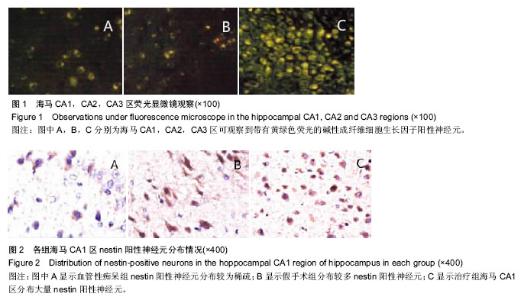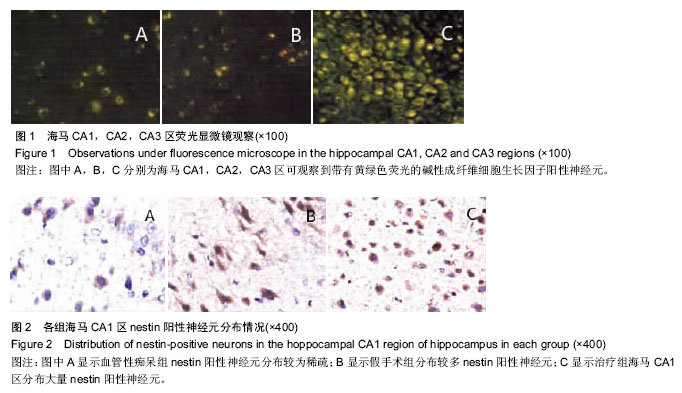Chinese Journal of Tissue Engineering Research ›› 2016, Vol. 20 ›› Issue (23): 3470-3475.doi: 10.3969/j.issn.2095-4344.2016.23.019
Previous Articles Next Articles
Subcutaneous injection of basic fibroblast growth factors promotes the proliferation of hippocampal neural stem cells in rats with vascular dementia
Liu Sen1, Dai Zhen-xia2, Wu Chun-fang1, Hu Jing1, Cui Bei1
- 1Department of Neurology, 2Department of Laboratory Medicine, Huaihe Hospital of Henan University, Kaifeng 475000, Henan Province, China
-
Received:2016-05-04Online:2016-06-03Published:2016-06-03 -
About author:Liu Sen, Master, Associate chief physician, Department of Neurology, Huaihe Hospital of Henan University, Kaifeng 475000, Henan Province, China -
Supported by:the Key Scientific Research Program of Universities in Henan, No. 20151120
CLC Number:
Cite this article
Liu Sen, Dai Zhen-xia, Wu Chun-fang, Hu Jing, Cui Bei . Subcutaneous injection of basic fibroblast growth factors promotes the proliferation of hippocampal neural stem cells in rats with vascular dementia[J]. Chinese Journal of Tissue Engineering Research, 2016, 20(23): 3470-3475.
share this article

2.1 实验动物数量分析 入组的30只动物均进入最终的结果分析,未出现脱落。 2.2 Morris水迷宫实验结果 血管性痴呆组的潜伏期显著长于假手术组和治疗组,进出目标象限次数显著少于假手术组和治疗组(P < 0.05)。假手术组和治疗组间比较,差异无显著性意义(P > 0.05),见表1。 2.3 组织荧光观察结果 经荧光显微镜观察,治疗组海马CA1、CA2、CA3区均可观察到带有黄绿色荧光的碱性成纤维细胞生长因子阳性神经元,见图1。 2.4 免疫组织化学染色结果 Nestin是目前识别神经干细胞的重要标志,经免疫组织化学染色和观察,nestin阳性神经元主要集中于海马CA1区。治疗组海马CA1区分布有大量的nestin阳性神经元,假手术组也分布较多的nestin阳性神经元,但血管性痴呆组nestin阳性神经元分布较为稀疏,说明碱性成纤维细胞生长因子可促进大鼠海马神经干细胞分裂,提高海马胆碱能神经元的密度,见图2。 2.5 海马CA1区nestin免疫反应阳性神经元计数 血管性痴呆组海马CA1区nestin阳性神经元数目显著少于假手术组和治疗组(P < 0.05)。假手术组和治疗组间比较,差异无显著性意义(P > 0.05),见表2。"

| [1] 叶建新,林航,穆军山,等.bFGF对血管性痴呆大鼠海马神经干细胞的影响[J].中国比较医学杂志,2009,19(11):1-4,插1. [2] 邢雪松,吕威力,赵海,等.碱性成纤维细胞生长因子促进血管性痴呆大鼠音猬蛋白的表达[J].解剖学杂志,2014, 37(6):771-774. [3] 王小月,周丽莎.电针对AD模型大鼠海马神经干细胞bFGF及学习记忆能力的影响[J].湖北中医学院学报, 2008,10(1):12-14. [4] 王振宇,佟雷,季丽莉,等.表皮生长因子培养条件下脑源性神经生长因子诱导大鼠海马神经干细胞向神经元分化的最佳浓度[J].中国组织工程研究与临床康复,2008,12(16): 3171-3174. [5] López-Toledano MA, Redondo C, Lobo MV, et al. Tyrosine hydroxylase induction by basic fibroblast growth factor and cyclic AMP analogs in striatal neural stem cells: role of ERK1/ERK2 mitogen-activated protein kinase and protein kinase C. J Histochem Cytochem. 2004;52(9):1177-1189. [6] 佟雷,谢大龙,高海,等.联合应用碱性成纤维细胞生长因子和脑源性神经营养因子对成年大鼠脑海马神经干细胞分化为神经元的影响[J].中国组织工程研究与临床康复, 2009,13(27):5331-5335. [7] Chen YJ, Deutsch G, Satya R, et al. A semi-quantitative method for correlating brain disease groups with normal controls using SPECT: Alzheimer's disease versus vascular dementia. Comput Med Imaging Graph. 2013;37(1):40-47. [8] Fu JL, Zhang T, Chang C, et al. The value of diffusion tensor imaging in the differential diagnosis of subcortical ischemic vascular dementia and Alzheimer's disease in patients with only mild white matter alterations on T2-weighted images. Acta Radiol. 2012;53(3):312-317. [9] 吕威力,邢雪松,张玲,等.bFGF在局灶性脑缺血后内源性神经干细胞增殖过程中对Id2的影响[J].解剖学研究, 2011, 33(1):9-12. [10] Meguro K, Tanaka N, Nakatsuka M, et al. Vascular lesions in mixed dementia, vascular dementia, and Alzheimer disease with cerebrovascular disease: the Kurihara Project. J Neurol Sci. 2012;322(1-2):157-160. [11] 黄斐,赵际童,沈强,等.神经球方法体外无血清含生长因子培养的神经干细胞主要向神经胶质细胞分化[J].中国组织工程研究,2012,16(1):81-84. [12] Ihl R, Tribanek M, Bachinskaya N, et al. Efficacy and tolerability of a once daily formulation of Ginkgo biloba extract EGb 761® in Alzheimer's disease and vascular dementia: results from a randomised controlled trial. Pharmacopsychiatry. 2012;45(2):41-46. [13] Choi SH, Kim S, Han SH, et al. Neurologic signs in relation to cognitive function in subcortical ischemic vascular dementia: a CREDOS (Clinical Research Center for Dementia of South Korea) study. Neurol Sci. 2012;33(4):839-846. [14] Stasiak A, Mussur M, Unzeta M, et al. Effects of novel monoamine oxidases and cholinesterases targeting compounds on brain neurotransmitters and behavior in rat model of vascular dementia. Curr Pharm Des. 2014; 20(2):161-171. [15] 曾维军.神经营养因子和生长因子在神经干细胞中的研究进展[J].临床与病理杂志,2015,35(3):484-489. [16] Wang N, Sun C, Huo S, et al. Cooperation of phosphatidylcholine-specific phospholipase C and basic fibroblast growth factor in the neural differentiation of mesenchymal stem cells in vitro. Int J Biochem Cell Biol. 2008;40(2):294-306. [17] Meguro K, Akanuma K, Meguro M, et al. Prognosis of vascular mild cognitive impairment includes vascular dementia onset and death by cardiovascular disease: reanalysis from the Osaki-Tajiri project. J Stroke Cerebrovasc Dis. 2012;21(7):607-611. [18] 李飞.大鼠脊髓损伤模型植入低氧启动血管内皮生长因子表达的神经干细胞的意义[D]. 呼和浩特市:内蒙古医科大学,2015. [19] 何精选,王艳炜,程雄飞,等.小鼠胚胎皮质、海马来源的神经干细胞在体外增殖特性的比较研究[J].解剖科学进展, 2010,16(3):277-280. [20] Suzuki Y, Yanagisawa M, Yagi H, et al. Involvement of beta1-integrin up-regulation in basic fibroblast growth factor- and epidermal growth factor-induced proliferation of mouse neuroepithelial cells. J Biol Chem. 2010;285(24):18443-18451. [21] 李蕊,戴园园,刘娜,等.发育期癫大鼠移植骨髓源性神经干细胞对海马BDNF和bFGF表达的影响[J].中国临床神经科学,2015,23(1):17-22. [22] Kuhad A,Arora V,Takyar J, et al. Neotric advances in vascular dementia - Highlights from the 7th International Congress on Vascular Dementia, October 20-23, 2011, Riga, Latvia. Drugs of the Future.2012; 37(3):209-219. [23] Zhang H, Sun R, Liu XY, et al. A tetramethylpyrazine piperazine derivate CXC137 prevents cell injury in SH-SY5Y cells and improves memory dysfunction of rats with vascular Dementia. Neurochem Res. 2014; 39(2):276-286. [24] 刘阳,刘卫平,王孝安,等.神经生长因子与表皮生长因子干预创伤性脑损伤后内源性神经干细胞的增殖[J].中国组织工程研究,2012,16(1):65-69. [25] Ma F, Xiao Z, Chen B, et al. Accelerating proliferation of neural stem/progenitor cells in collagen sponges immobilized with engineered basic fibroblast growth factor for nervous system tissue engineering. Biomacromolecules. 2014;15(3):1062-1068. [26] Gu Y, Xue C, Zhu J, et al. Basic fibroblast growth factor (bFGF) facilitates differentiation of adult dorsal root ganglia-derived neural stem cells toward Schwann cells by binding to FGFR-1 through MAPK/ERK activation. J Mol Neurosci. 2014;52(4):538-551. [27] 何峻峰,顾国妹,龙大宏,等.神经生长因子重组反转录病毒载体在神经干细胞中的表达[J].中国组织工程研究,2014, (19):3100-3104. [28] Zhang XL, Zheng SL, Dong FR, et al. Nimodipine improves regional cerebral blood flow and suppresses inflammatory factors in the hippocampus of rats with vascular dementia. J Int Med Res. 2012;40(3): 1036-1045. [29] Meguro K, Akanuma K, Ouchi Y, et al. Vascular dementia with left thalamic infarction: neuropsychological and behavioral implications suggested by involvement of the thalamic nucleus and the remote effect on cerebral cortex. The Osaki-Tajiri project. Psychiatry Res. 2013;213(1):56-62. [30] 龙琦,尹晓娟,封志纯,等.神经生长因子和碱性成纤维细胞生长因子对缺氧缺血脑损伤新生大鼠内源性神经干细胞的影响[J].实用医学杂志,2009,25(1):36-39. [31] 盛宝英,魏春杰,杨晓玉,等.bFGF和BDNF对MCAO大鼠海马区神经干细胞原位增殖的影响[J].黑龙江医药科学, 2010,33(3):1-2. [32] Maric D, Fiorio Pla A, Chang YH, et al. Self-renewing and differentiating properties of cortical neural stem cells are selectively regulated by basic fibroblast growth factor (FGF) signaling via specific FGF receptors. J Neurosci. 2007;27(8):1836-1852. [33] Zhu H, Yang A, Du J, et al. Basic fibroblast growth factor is a key factor that induces bone marrow mesenchymal stem cells towards cells with Schwann cell phenotype. Neurosci Lett. 2014;559:82-87. [34] Maric D, Maric I, Chang YH, et al. Prospective cell sorting of embryonic rat neural stem cells and neuronal and glial progenitors reveals selective effects of basic fibroblast growth factor and epidermal growth factor on self-renewal and differentiation. J Neurosci. 2003; 23(1):240-251. [35] 李伟伟,姚星宇,杨丽敏,等.体外诱导人脐带间充质干细胞向神经干细胞的分化[J].中国组织工程研究,2014,18(1): 75-80. [36] 任铭新.BDNF和bFGF对全脑缺血再灌注大鼠内源性神经干细胞的影响[D]. 郑州:郑州大学,2010. [37] Perri R, Fadda L, Caltagirone C, et al. Word list and story recall elicit different patterns of memory deficit in patients with Alzheimer's disease, frontotemporal dementia, subcortical ischemic vascular disease, and Lewy body dementia. J Alzheimers Dis. 2013;37(1): 99-107. [38] Tanaka N, Nakatsuka M, Ishii H, et al. Clinical utility of the functional independence measure for assessment of patients with Alzheimer's disease and vascular dementia. Psychogeriatrics. 2013;13(4):199-205. [39] 李晓波.人胚脑神经干细胞的分离培养和鉴定及bFGF、EGF对脑缺血大鼠自体神经干细胞增殖的影响[D].南京:南京医科大学,2004. [40] 苏静,肖颂华,刘军,等.碱性成纤维细胞生长因子调节Notch信号通路下游蛋白参与神经干细胞抗辐射损伤的实验研究[J].中华行为医学与脑科学杂志,2014, 23(10): 875-877. |
| [1] | Zhang Tongtong, Wang Zhonghua, Wen Jie, Song Yuxin, Liu Lin. Application of three-dimensional printing model in surgical resection and reconstruction of cervical tumor [J]. Chinese Journal of Tissue Engineering Research, 2021, 25(9): 1335-1339. |
| [2] | Guan Qian, Luan Zuo, Ye Dou, Yang Yinxiang, Wang Zhaoyan, Wang Qian, Yao Ruiqin. Morphological changes in human oligodendrocyte progenitor cells during passage [J]. Chinese Journal of Tissue Engineering Research, 2021, 25(7): 1045-1049. |
| [3] | Zeng Yanhua, Hao Yanlei. In vitro culture and purification of Schwann cells: a systematic review [J]. Chinese Journal of Tissue Engineering Research, 2021, 25(7): 1135-1141. |
| [4] | Xu Dongzi, Zhang Ting, Ouyang Zhaolian. The global competitive situation of cardiac tissue engineering based on patent analysis [J]. Chinese Journal of Tissue Engineering Research, 2021, 25(5): 807-812. |
| [5] | Wu Zijian, Hu Zhaoduan, Xie Youqiong, Wang Feng, Li Jia, Li Bocun, Cai Guowei, Peng Rui. Three-dimensional printing technology and bone tissue engineering research: literature metrology and visual analysis of research hotspots [J]. Chinese Journal of Tissue Engineering Research, 2021, 25(4): 564-569. |
| [6] | Chang Wenliao, Zhao Jie, Sun Xiaoliang, Wang Kun, Wu Guofeng, Zhou Jian, Li Shuxiang, Sun Han. Material selection, theoretical design and biomimetic function of artificial periosteum [J]. Chinese Journal of Tissue Engineering Research, 2021, 25(4): 600-606. |
| [7] | Liu Fei, Cui Yutao, Liu He. Advantages and problems of local antibiotic delivery system in the treatment of osteomyelitis [J]. Chinese Journal of Tissue Engineering Research, 2021, 25(4): 614-620. |
| [8] | Li Xiaozhuang, Duan Hao, Wang Weizhou, Tang Zhihong, Wang Yanghao, He Fei. Application of bone tissue engineering materials in the treatment of bone defect diseases in vivo [J]. Chinese Journal of Tissue Engineering Research, 2021, 25(4): 626-631. |
| [9] | Zhang Zhenkun, Li Zhe, Li Ya, Wang Yingying, Wang Yaping, Zhou Xinkui, Ma Shanshan, Guan Fangxia. Application of alginate based hydrogels/dressings in wound healing: sustained, dynamic and sequential release [J]. Chinese Journal of Tissue Engineering Research, 2021, 25(4): 638-643. |
| [10] | Chen Jiana, Qiu Yanling, Nie Minhai, Liu Xuqian. Tissue engineering scaffolds in repairing oral and maxillofacial soft tissue defects [J]. Chinese Journal of Tissue Engineering Research, 2021, 25(4): 644-650. |
| [11] | Xing Hao, Zhang Yonghong, Wang Dong. Advantages and disadvantages of repairing large-segment bone defect [J]. Chinese Journal of Tissue Engineering Research, 2021, 25(3): 426-430. |
| [12] | Chen Siqi, Xian Debin, Xu Rongsheng, Qin Zhongjie, Zhang Lei, Xia Delin. Effects of bone marrow mesenchymal stem cells and human umbilical vein endothelial cells combined with hydroxyapatite-tricalcium phosphate scaffolds on early angiogenesis in skull defect repair in rats [J]. Chinese Journal of Tissue Engineering Research, 2021, 25(22): 3458-3465. |
| [13] | Wang Hao, Chen Mingxue, Li Junkang, Luo Xujiang, Peng Liqing, Li Huo, Huang Bo, Tian Guangzhao, Liu Shuyun, Sui Xiang, Huang Jingxiang, Guo Quanyi, Lu Xiaobo. Decellularized porcine skin matrix for tissue-engineered meniscus scaffold [J]. Chinese Journal of Tissue Engineering Research, 2021, 25(22): 3473-3478. |
| [14] | Mo Jianling, He Shaoru, Feng Bowen, Jian Minqiao, Zhang Xiaohui, Liu Caisheng, Liang Yijing, Liu Yumei, Chen Liang, Zhou Haiyu, Liu Yanhui. Forming prevascularized cell sheets and the expression of angiogenesis-related factors [J]. Chinese Journal of Tissue Engineering Research, 2021, 25(22): 3479-3486. |
| [15] | Liu Chang, Li Datong, Liu Yuan, Kong Lingbo, Guo Rui, Yang Lixue, Hao Dingjun, He Baorong. Poor efficacy after vertebral augmentation surgery of acute symptomatic thoracolumbar osteoporotic compression fracture: relationship with bone cement, bone mineral density, and adjacent fractures [J]. Chinese Journal of Tissue Engineering Research, 2021, 25(22): 3510-3516. |
| Viewed | ||||||
|
Full text |
|
|||||
|
Abstract |
|
|||||

